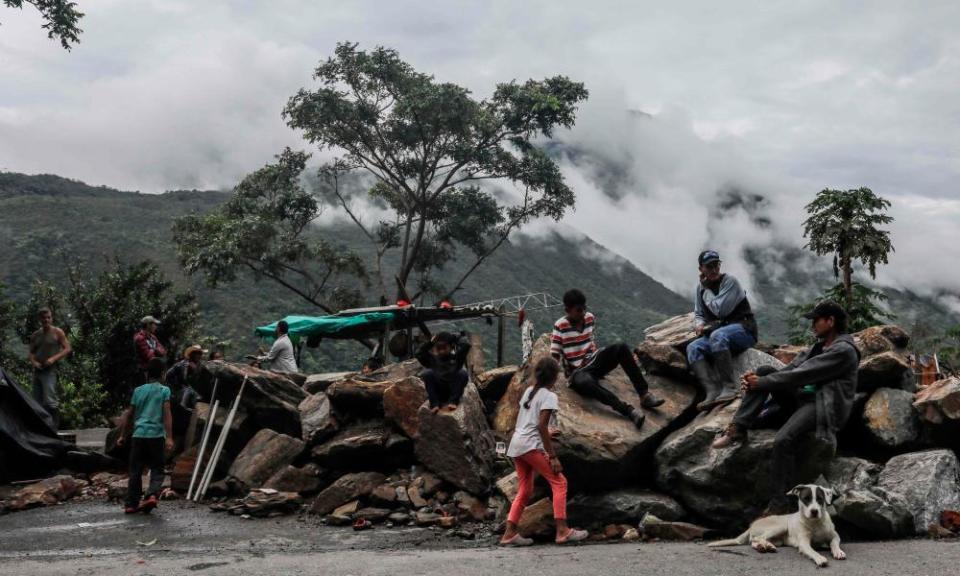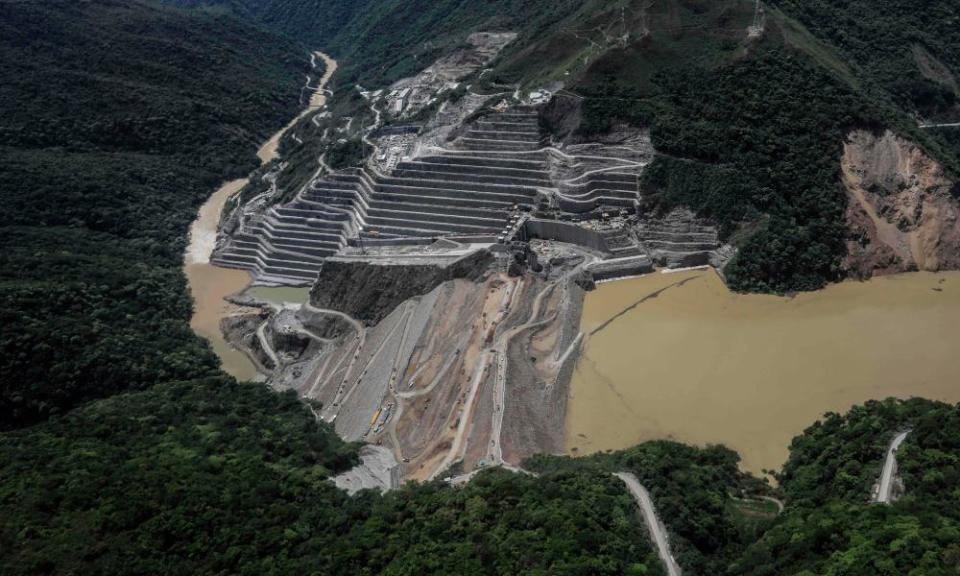Colombians who once fled war now forced to run from catastrophic flooding
Following a peace deal with rebels, another conflict threatens residents: a massive dam project that has displaced thousands

It is nearly 20 years since Eva Celdi Higuita was forced to run from her home on the banks of the river Cauca in western Colombia by leftwing rebels.
Now, she has been forced to flee the same patch of land once more, after floods caused by a massive new dam project left her home underwater.
“It happened from one moment to another,” Higuita said, wringing her frail hands with agitation. She and 14 family members are now sharing a tiny house in the town of Sabanalarga, about an hour’s walk from the muddy waters of the rising river. “We had to run like we were running from an armed group.”
The Bajo Cauca region in the western province of Antioquia was once a battleground as the rival factions in Colombia’s multi-sided civil war jostled for control. Massacres and pitched battles were commonplace – and all too often civilians were caught in the middle.
But following a peace deal with Colombia’s largest rebel group, the leftist Revolutionary Armed Forces Colombia (Farc), another conflict has come into focus: one unleashed by massive development projects that upend livelihoods and displace thousands of the people they purport to help.
After a tunnel collapsed last month at Colombia’s largest hydroelectric dam project, heavy floods displaced hundreds and led authorities to evacuate thousands more. Since then, torrential downpours and a spate of landslides have caused water levels along the river to rise, putting up to 120,000 more people at risk should the Hidroituango dam breach.
If that happens, or should water cascade over its wall – both risks that the United Nations Environment Programme has highlighted – the consequences could be catastrophic both for those living nearby – and for EPM, the state-owned company behind the project.
EPM workers are rushing to repair and complete the dam, but they have occasionally been evacuated as geological conditions worsen.
Meanwhile, in Sabanalarga, about 200 people are sleeping rough in the public square without any aid from the government. Others have taken refuge in an EPM office and the town’s school.
Higuita, who is illiterate, used to pan for gold at the riverside, and has no work prospects in Sabanalarga. “What can we do now? Where will we work?”

Before running from the floodwaters, Higuita – a member of the Nutabe indigenous group – had already been displaced three times by violence.
This region, about 100 miles north of the city of Medellín, was for decades the setting for conflict between leftwing rebels and paramilitary militias allied with state forces. In the 12 municipalities close to the dam, local activists have documented 73 massacres since the 1980s.
A 2016 peace deal with the Farc formally ended five decades of civil war, but for the communities around Hidroituango, however, peace still seems distant.
“We haven’t seen anything of the peace process here,” said Fredy García, a fisherman who used to supplement his income by panning for gold.
García’s brother disappeared in 1999 after a skirmish between guerrilla fighters and paramilitaries. His body was never found, and García suspects that his unmarked grave – like many others – is now under flood water.
Ríos Vivos, a local campaign group opposed to the Hidroituango project, claims that about 700 bodies may already be lost to the flooding, some in civil war mass graves and others in indigenous cemeteries.
EPM says it has worked to exhume and relocate about 300 cadavers from gravesites at risk of flooding, though the majority have decomposed so much they can no longer be identified.
And many in Sabanalarga say that this latest displacement has been the most distressing. “This is way worse than being forced out by armed groups,” said Guillermo González, another refugee. “Now we can’t go back because the river is too high – and nature didn’t cause this.”
Locals say that EPM has effectively supplanted the state in the region. The company has deployed riot police to force nomadic indigenous communities from land assigned to the megaproject – something permitted by law as the dam is considered to be of public use. It has also contracted four private security companies and a handful of military and police battalions.
Unlike victims of conflict, those displaced by development projects have no access to compensation from the Colombian state, and find themselves in an even more precarious situation.
Those who give up their lands to Hidroituango – or any of a plethora of mining and palm oil projects across the country – rely on handouts from the corporations working the land.
EPM did not respond to requests for comment, while representatives from Colombia’s environment ministry were not available for interview.
Colombian authorities do not keep track of how many have been affected by development projects, though 15 million people worldwide are forced to leave their homes every year for such schemes, according to a recent study.
In stark contrast to the scenes at Sabanalarga, humanitarian assistance is plentiful in Valdivia, a town 25 miles downstream from the dam: pickup trucks emblazoned with Red Cross logos carry food parcels around the town and the school and public football pitch have been repurposed as shelters, with about 700 people in temporarily accommodated.
William Gutiérrez, a fisherman and gold prospector, now shares a tent with his brother and a stranger after escaping the floods last month, with nothing but the clothes he was wearing.
It wasn’t the first time he had fled.
In 1997, rightwing paramilitaries arrived at his home in the remote hamlet of El Aro, hunting for Farc collaborators. One of his younger brothers was accused of being a rebel supporter and was murdered along with 14 others.
Gutiérrez claims the militiamen told him they were there to clear land for the nascent hydroelectric dam project.
“They said that we were on land that would be used [for the dam],” said Gutiérrez. “When we refused to leave, that’s when they started shooting.”
In his eyes, the flood was a tragedy foretold. “We’ve always said this river could not be dammed,” he said as vultures circled overhead. “But the dam is more important to those in power than our lives.”
At the dam site, locals now wait for hours to cross the new reservoir on a boat service provided by the company. The road they used to take is now at the bottom of the reservoir, while a tunnel through the mountains was recently blocked by a landslide.
Despite the controversies, the Hidroituango dam is being touted as a landmark project by the government and EPM. At full capacity the dam should be capable of generating an annual average of 13,930 gigawatt hours through its eight massive turbines.
The project has received funding from IDB Invest, the private-sector branch of the Inter-American Development Bank and a number of private banks.
Locals filed a complaint to the IDB to investigate whether its investment wing broke environmental and social standards.
Isabel Zuleta, a vocal Ríos Vivos activist, questions the necessity of the project. “Colombia’s current energy production is sufficient for the nation, but international markets are already buying energy from here,” she said.
Zuleta also worries about the security of those who campaign against the dam: two other Ríos Vivos members in Antioquia were murdered last month, part of a worrying trend in Colombia. In the first, after the peace deal was signed, 121 human rights defenders were killed.
“Our main concern is getting through this alive,” Zuleta said.

